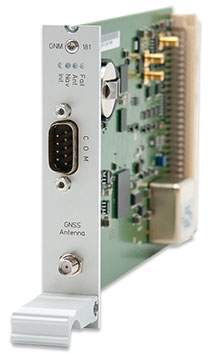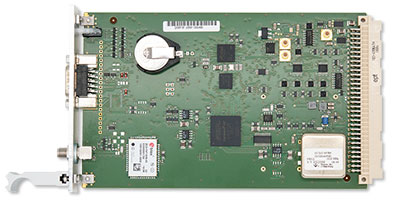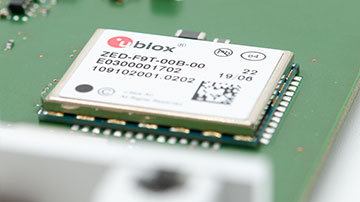IMS-GNM: GNSS MULTI BAND Based Time Synchronization
Key Features


- RS-232 interface
- Allows direct transmission routes of up to 150 m when using Ultraflex H2010 coaxial cable
- Compatible with IMS-CLK slots
- Oscillator Options: OCXO-SQ, OCXO-HQ, OCXO-DHQ
- Combined 184-channel GPS / Galileo / GLONASS / Beidou receiver
- Synthesizer 1/8 Hz up to 10 MHz (TTL level, sine wave 1.5Veff, open drain)
4 programmable TTL outputs and timecode generator (IRIG-B, AFNOR)
Product Description
The module provides differential timing mode for highly accurate local timing and built-in security for highest robustness against malicious attacks. The variety of inputs/outputs makes this combined GNSS receiver (GPS, GLONASS, Galileo & Beidou) the first choice for a broad range of applications, including time and frequency synchronization tasks and the measurement of asynchronous time events.
The frequency locking of the master oscillator to the GNSS system enables the GNM system to generate fixed and optionally programmable standard frequencies with high accuracy and stability. Various oscillator options allow the cost efficient implementation of different requirements concerning the accurracy of the outputs. The pulse generator of the GNM multi band receiver generates pulses per second and per minute. As an option four programmable outputs are available. The pulses are synchronized to UTC-second. Up to four serial interfaces are available for sending timestrings. These ASCII-telegrams include information regarding time, date and status of the GNM-receiver.
The module provides two inputs for measurement of asynchronous time events. These capture events can be read via a serial interface. The parameter setting of the module is done by a monitor software.
Characteristics
| Receiver | 184 channel GPS / Galileo / GLONASS / Beidou receiver
Supported GNSS and Signals: GPS: L1C/A (1575.42 MHz) L2C (1227.60 MHz) GLONASS: L1OF (1602 MHz + k*562.5 kHz L2OF (1246 MHz + k*437.5 kHz k = -7,..., 5, 6 Galileo: E1-B/C (1575.42 MHz) E5b (1207.140 MHz) Beidou: B1I (1561.098 MHz) B2I (1207.140 MHz) Antenna connector: SMA |
| Status Indicators |
|
| Type of Antenna | GNMANTv2: Dual-Band Multi-Frequency Antenna for GPS, Galileo, GLONASS and BeiDou reception |
| Synchronization Time |
< 1 minute in normal operation mode,
approx. 1 minute after a cold start (12 minutes in GPS-only mode) |
| Frequency Outputs | Frequency Synthesizer for arbitrary frequencies between 0.125 Hz and 10 MHz, adjustable phase, output via external modules such as IMS-BPE modules |
| Pulse Outputs | Pulse per second (PPS) and pulse per minute (PPM). TTL level, pulse width: 200 msec |
| Accuracy of Pulse Outputs |
< ±50 ns (OCXO-SQ, OCXO-MQ, OCXO-HQ)
< ±20 ns (OCXO-DHQ) |
| Interface | Single serial RS-232 interface |
| Serial Time String Output | Baud Rates: 300, 600, 1200, 2400, 4800, 9600, 19200 Baud Framing: 7E1, 7E2, 7N2, 7O1, 7O2, 8E1, 8N1, 8N2, 8O1 Time String Formats: Meinberg Standard Time String , SAT, Uni Erlangen (NTP), SPA, Sysplex, RACAL, NMEA0183 (RMC,GGA,ZDA), Meinberg GPS, COMPUTIME, ION, Capture String |
| Switch outputs | Four TTL outputs can configured independently for the following modes: - free programmable cyclic or fixed impulses - timecode - timer mode; three 'ON'- and three 'OFF'-states can be setup per day The switch states can be inverted for all three outputs, the impulse lengths are configurable. The impulse output can be configured for all channels together to 'always' or 'ifsync'. |
| Supported Timecode Formats |
IRIG B002: 100pps, DCLS signal, no carrier, BCD time-of-year IRIG B122: 100pps, AM sine wave signal, 1 kHz carrier, BCD time-of-year IRIG B003: 100pps, DCLS signal, no carrier, BCD time-of-year, SBS time-of-day IRIG B123: 100pps, AM sine wave signal, 1kHz carrier, BCD time-of-year, SBS time-of-day IRIG B006: 100 pps, DCLS Signal, no carrier, BCD time-of-year, year IRIG B126: 100 pps, AM sine wave signal, 1 kHz carrier frequency, BCD time-of-year, Year IRIG B007: 100 pps, DCLS Signal, no carrier, BCD time-of-year, year, SBS time-of-day IRIG B127: 100 pps, AM sine wave signal, 1 kHz carrier frequency, BCD time-of-year, year, SBS time-of-day IEEE1344: Code according to IEEE1344-1995, 100pps, AM sine-wave signal, 1kHz carrier, BCD time-of-year, SBS time-of-day, IEEE1344 expansion for date, time zone, daylight saving and leap second in Control Functions segment C37.118: Like IEEE1344 - with inverted sign bit for UTC offset AFNOR: Code according to NFS-87500, 100pps, AM sine-wave signal, 1kHz carrier, BCD time-of-year, complete date, SBS time-of-day |
| Backup Battery Type |
CR2032 (lithium button cell)
In the event of loss of power to the main system, this battery powers the real-time clock and also ensures that GNSS almanac data is properly buffered in RAM. Lifetime of lithium battery: Min. 10 years |
| Cable Type | Speedfoam 240HFJ max. length 70 m (230 ft) |
| Operating Voltage | +5 V DC |
| Current Draw | +5 V 1,1 A to 1,4 A (depends on oscillator option) |
| Supported Temperature | Operational: 0 - 50 °C (32 - 122 °F)
Storage: -20 - 70 °C (-4 - 158 °F) |
| Supported Humidity | Max. 85 % (non-condensing) at 40 °C |
| Contents of Shipment | The system will be delivered inclusive GNSS MULTI BAND ANTENNA, mounting kit and 20 m coax-cable (Belden H155). |
| Warranty | Three-year warranty |
| RoHS Status of Product | This product is fully RoHS-compliant. |
| WEEE Status of Product | This product is handled as a B2B (Business to Business) category product. To ensure that the product is disposed of in a WEEE-compliant fashion, it can be returned to the manufacturer. Any transportation expenses for returning this product (at end-of-life) must be covered by the end user, while Meinberg will bear the costs for the waste disposal itself. |
Downloads
Data Sheet
Short Info Sheet
Manuals
- For drivers, SDKs, tools and utilities, please check our Download Section






